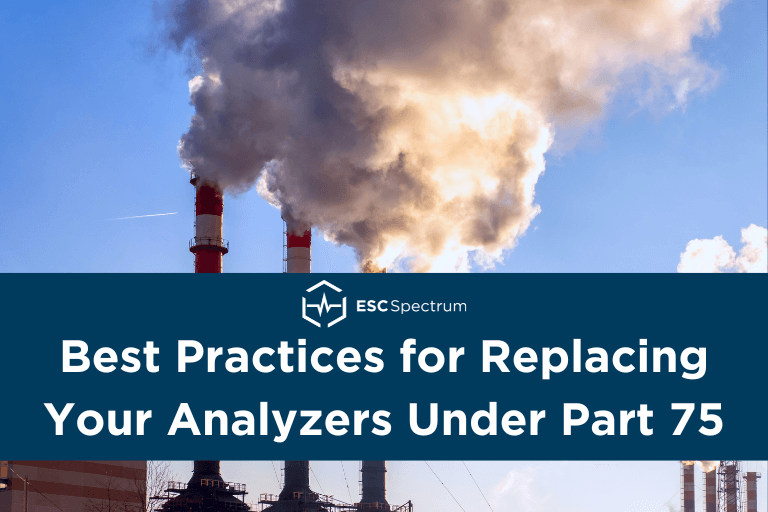Replacing Analyzers Under Part 75
Maintaining compliance with air quality regulations is paramount in industrial and utility plants. Analyzer replacement and compliance testing under 40 CFR Part 75 are complex processes requiring careful planning and execution. Expert discussions highlight key considerations and best practices for navigating these challenges.
Reasons & Considerations for Analyzer Replacement
Analyzers have a finite lifespan, and various factors, such as obsolescence, poor material history, and limited parts/services availability, may necessitate replacement. Replacement costs vary depending on factors like manufacturer, analyzer type, additional equipment required, and new analytical features. Treating analyzer replacement as a project involves careful planning of scope, budget, and schedule. Regulatory review, installation, and stack testing for certification are integral parts of the process.
Are your Analyzers Obsolete? Read our blog post to see if we can help identify if your CEMS analyzers need upgrading.
Compliance Testing Procedures for Replacing Analyzers
The first passing online calibration establishes a conditional data validation, marking the beginning of the compliance tests. The pass/fail criteria for SO2, NOx, CO2, O2, and flow are outlined, with certain alternative performance specifications available under specific conditions.
Conducted 21 consecutive unit operating days after the first CAL, the drift test evaluates the stability of the analyzer’s measurements over time. It requires seven consecutive CALs with the same pass/fail criteria as the probationary CAL.
The test measures the time taken for a 95% step change from the stack flue gas concentration value to the bottle value. It involves injecting zero and high-span bottle gases and recording the time to achieve the step change within 15 minutes. Under Part 75, it’s a single test, and there’s no need to run it multiple times.
Conducted after 168 consecutive unit operating hours post-first CAL, the linearity check verifies the analyzer’s response across different gas concentration levels. Pass/fail criteria are defined based on the absolute value of reference gases compared to actual gases.
The RATA compares actual measurements to reference method data, requiring a minimum of nine test runs at each tested load. Bias testing is performed concurrently during relative accuracy testing, with incentives for passing on a semi-annual and annual basis.
Records containing relevant information on test performance and completion must be created for each compliance test. These records are submitted quarterly, including start and end dates, conditional data validation details, QA event and test codes, and DAS-generated QA files.
Thorough documentation and adherence to regulatory requirements are essential throughout the testing process. Specific considerations include probe location in the stack, adherence to engineering specifications, and conducting interference tests to avoid compliance issues.
Reference Gases and Installation Considerations
Ensuring the availability of reference gases is crucial for certifying the new analyzer. Considerations include single concentrations, blended concentrations, and consolidation to minimize technician workload. Installation considerations include engineering and regulatory efforts, demolition versus installation, and updates to plant Monitoring and QA/QC plans.
Monitoring Plans & QA/QC Revisions
Updating monitoring plans and component IDs is necessary when replacing analyzers. ESC Spectrum can assist in reviewing monitoring plans upfront and ensuring alignment with QA/QC plans to streamline the process.
Read more about our Comprehensive Overview of Monitoring Plans.
Learn why keeping your facility’s QA/QC plan up-to-date for facility safety and audit preparedness is important.
Analyzer Brand Comparison
No significant differences exist between brands like Thermo and Teledyne regarding technology. However, standardizing across the fleet is advantageous for spare parts management and consistency. ESC Spectrum can provide comparisons and assist in selecting the most suitable technology based on specific regulatory requirements and site needs. Our partnerships with our Suppliers ensure your plant acquires the right equipment at the right price.
We're Here to Help
Thorough preparation, adherence to regulatory requirements, and leveraging expert support are critical for ensuring accurate and reliable emissions monitoring. By following best practices and seeking assistance when needed, industrial and utility plants can maintain compliance with air quality regulations effectively.
If you need assistance with regulatory, installation, or recertification processes for replacing your analyzers, please contact our ESC Spectrum experts. We have everything you need to help you meet air emissions monitoring and compliance requirements.
Visit our Analyzer services webpage to see what we have to offer.
Interested in learning a more comprehensive overview of how CEM Systems work? Read Understanding Continuous Emissions Monitoring Systems (CEMS): A Comprehensive Guide. This guide will give you a complete understanding of all the components in the flow of a CEMS.
Interested in learning more about regulations and staying in compliance? Read our Definitive Guide to Air Emissions Regulations.

Taylor Hempel - Marketing Specialist II
Taylor Hempel is a skilled marketer specializing in content creation, social media management, and driving customer engagement. With a BBA in Marketing from the University of Texas at San Antonio, she joined ESC Spectrum in February 2022. Taylor is adept at crafting informative content about continuous emissions monitoring systems, its components and data acquisition systems allowing her to craft content that educates and informs industry professionals.


